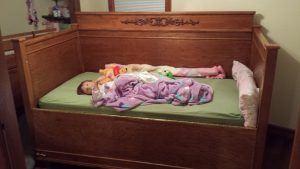--Originally published at FLN – matthewtmoore
#Flipblogs entry: How starting with the end can still allow for creativity.
There are as many different ways of creating things as there are reasons for creating them. Many times the method of creation has as much to do with the personality creating the item as it does with the item itself or the purpose of the item. Even a single person with a particular temperament can create in a variety of ways. Let me give you a few examples.
Creating to Specification
Although I don’t consider myself a “creative type”, I am somewhat creative in my own ways. I looked around my house, and I found a couple items that represent my creativity. The first is creation of a piece of furniture for my daughter that fit a very specific, and special, need. My daughter has some special needs and she is also very tall, even for her age, so she quickly outgrew her crib situation. As her height and weight increased we needed ways two transfer her in and out of bed more easily while giving her a comfortable place to sleep that was safe for her. The result was what amounts to a very large crib/daybed with a drop down side for her safety. Her bed also is on casters so that we can work all the way around it to remake it, clean it, and get to whatever we need. We also included under-bed storage for the many things that come along with children, so storage is always a necessity. I specifically made it look as if it set on its legs rather than on the hidden casters because that was one of my wife’s requirements. This build is a great example of “creating with the end in mind”. My wife had a long list of specific requirements, believe me they she required them. It was my job to create something that fit the needs, but also fit her aesthetic sense, while creating something that did not look like a medical device.
Free-Form Creation
Another item, that I created against my wife’s wishes, was a laundry basket holder for the utility room remodel that I did for her. She had in her mind a very specific design that she wished to have, and I summarily threw it out. I wanted to turn an old headboard and footboard into a laundry basket holder, basically to suit my own creative desire. Beyond the holding laundry baskets and the starting material, I had no requirements for form or for design and I created it as I went along using the materials that I had. As the great Bob Ross said “there are no mistakes, just happy accidents” and while she loved the result, this was not at all the “end” that she had in mind, but I got to flex my creative muscle.
As an aside, Bob Ross always did three of every painting for his TV show, so even in happy accidents there is opportunity for revision and improvement. https://youtu.be/LwApjDJ2sqo
Creativity with Direction
The final project is a mix between the two previous methods. For this project I had a defined space, and a requirement for a place to store shoes in bulk. I wished to have a sink in the laundry room, she didn’t. She wanted more shoe storage, I wanted to limit the “shoe-borg”. The result was a combination between setting out with an end goal to be reached, but also working within that goal to provide for freedoms and choices to suit all the stakeholders. In the end, I used a prefabbed sink cabinet and fitted it with pull out shoe shelves. I added the RV style sink cover (the waste cutout from installing the sink) to preserve maximum counter top space. I even found space to add a storage for the dustbuster (because we have two children) by using a prefabbed upper cabinet with modification to take advantage of the full counter top height. The “end” was met, but because I looked at the project with a creative eye, I was able to accomplish more than just the desired “end”.

UMMM … Is this Pinterest?
Thus far, this article hasn’t sounded much like an article on flipped learning, but more like a Pinterest entry, however, I think the same rules apply.
GET ON WITH IT!!!
Every teacher is their own unique individual, and has their own and unique ways of creating. Depending on age level we teach, or subject matter, there are also a variety of different requirements for whatever it is that we create. Most of the time we feel as if we are in the first situation with a long list of very specific requirements that must be met to satisfy the various stakeholders; the district, the parents, the edu-professionals, or legal requirements. The result is that we feel as if there is little room for us to create our masterpiece.
Rarely do we feel we’ve been given the flexibility or the opportunity to create as in the laundry basket situation, where we are free to form what we wish out of whatever we choose to begin using. While artists and musicians tell us this is the only true way to create, the reality is that in many cases this type of creation can be handicapping by having a blessing of too many options.
The truth is most creation limitations set ON the teacher, are set BY the teacher. If we choose to focus on all of the requirements, and all of the stakeholders, and all of the voices that tell us what to do, we find ourselves trapped, limited, and unfulfilled. On the other hand, some among us choose to take the “different path”, and we find ourselves handicapped by our own grand scope and lack of direction.
Creativity Within Constraint
While I can’t definitively say any method of creation is objectively better, I do suggest approaching creation for your classroom, and specifically creation and flipped learning, with the mindset of the shoe cabinet project. In almost every case, there are space and or time constraints that we have to deal with, and those are immutable within the bounds of the physics of education. However, if we choose, by conscious mindset, to allow those “ends” to give direction rather than limitation, we can work within those bounds to create our own unique spin on a particular project. This also allows us to include items that were not in the requirements, but meet our desire to share with students in a way that we feel is critical and important.
When we look with both the restrictions and the opportunities in mind, we will find we might even have opportunity to include things beyond what is required, and beyond what we originally want. By eliminating the mental restrictions we put on ourselves of what students will or will not accept, or what administration will or will not accept, or what traditionally has or has not been accepted, and by working with stakeholders and approaching things and a creative mindset, we can both accomplished with creativity and direction the “end” that we seek.

Addendum
There is one more lesson that I think I would be remiss in not including, and that that is when we choose to be creative, even within bounds or restrictions, we will find that the creation may miss the intended mark. The unintended joy is that we will rarely miss the mark because we fail to meet it, but more often, because we create a good beyond our intent. The most important thing is that when we approach this job of education, we remember that it is done with a primary stakeholder in mind; “what is good for students?”, and put all our creativity into meeting that stakeholder’s need.






